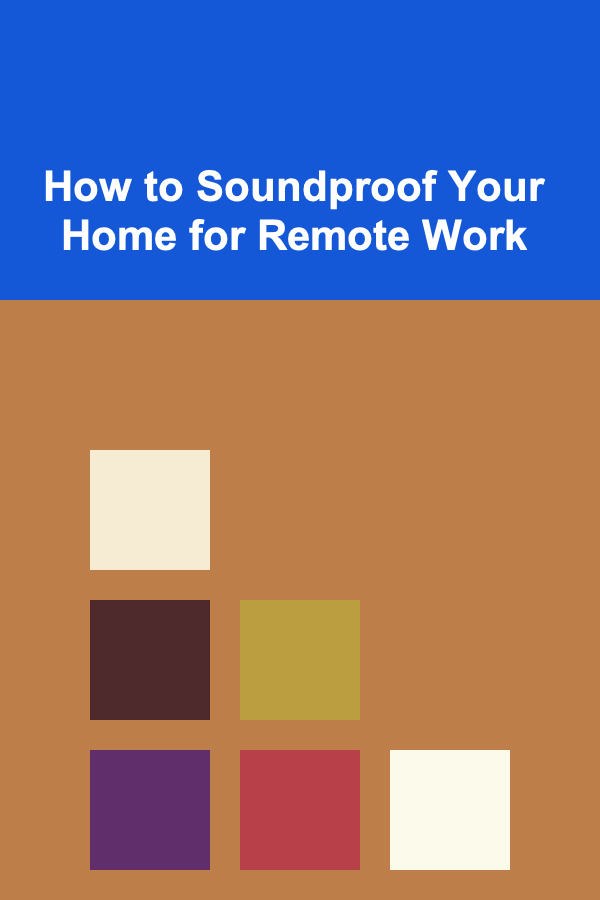
How to Soundproof Your Home for Remote Work
ebook include PDF & Audio bundle (Micro Guide)
$12.99$5.99
Limited Time Offer! Order within the next:

In recent years, remote work has become more than just a trend; it's now an essential aspect of many people's professional lives. Whether you're a freelancer, a full-time employee, or a business owner, working from home offers flexibility and comfort, but it also presents unique challenges. One of the most significant obstacles is noise. For those who need peace and quiet to focus, noise distractions from outside, neighbors, household members, or even the hum of your own appliances can severely impact productivity.
Soundproofing your home to create a more conducive working environment is no longer a luxury but a necessity. In this article, we'll explore effective strategies and techniques to soundproof your home for remote work, focusing on both common and advanced methods to reduce noise and create an optimal space for focus, creativity, and productivity.
Understanding the Importance of Soundproofing for Remote Work
Before delving into the techniques of soundproofing, it's important to understand why creating a quiet workspace is crucial for remote work. Working from home requires mental focus, and any noise distraction, whether it's from a neighbor's dog barking, a noisy street, or children playing in the background, can break that concentration.
Research has shown that noise can significantly impact productivity, creativity, and overall mental health. According to studies, consistent exposure to high levels of noise can lead to stress, fatigue, and a decrease in cognitive performance. Thus, by soundproofing your workspace, you're not just enhancing your work environment; you're also fostering your well-being and mental clarity.
Identifying the Sources of Noise in Your Home
Before you can begin soundproofing your space, you must first identify where the noise is coming from. Noise can enter your home through various channels, and it's essential to address each source for optimal results. There are three main types of noise that affect your remote work environment:
- External Noise: This includes noise from the outside world, such as traffic, construction, neighbors, or street sounds. It's usually transmitted through windows, doors, and walls.
- Internal Noise: Noise that originates from inside your home, such as the hum of appliances, conversations in other rooms, or sounds from other household members.
- Impact Noise: This noise occurs when something physically impacts a surface. For example, footsteps on hard floors or heavy furniture being moved. It tends to travel through floors and ceilings and is often a significant issue in apartment living.
Once you've identified the primary sources of noise, you can then tailor your soundproofing efforts accordingly.
Soundproofing Strategies
1. Seal Gaps and Cracks
One of the simplest and most cost-effective methods of reducing noise is to seal gaps and cracks. Sound travels through even the smallest openings, so ensuring that your home is tightly sealed can dramatically reduce sound transmission. Here's how to start:
- Windows and Doors: Use weatherstripping or acoustic sealant to seal gaps around windows and doors. Even small cracks allow significant noise infiltration, so it's crucial to address them.
- Electrical Outlets: Cover electrical outlets with foam or acoustic outlet covers to prevent noise from seeping through these openings.
- Walls and Ceilings: If your walls have cracks or gaps, consider using caulking or expanding foam to fill in the spaces.
These simple fixes can drastically cut down the amount of sound entering or leaving your workspace.
2. Install Soundproofing Curtains
Soundproofing curtains are an excellent solution for blocking out external noise, particularly from windows that face busy streets or noisy neighbors. These heavy, thick curtains are designed to absorb sound waves and prevent them from entering or exiting the room.
- Material Matters: Look for curtains made of dense materials such as velvet, polyester, or specially designed acoustic fabrics. The thicker the material, the more effective it will be at reducing sound.
- Cover Entire Windows: Make sure the curtains cover the entire window area and even extend beyond the window frame. Gaps in coverage can allow sound to pass through.
While soundproofing curtains won't completely eliminate external noise, they can significantly reduce it, creating a quieter environment.
3. Soundproof the Walls
Walls are the most common pathway for sound to travel between rooms or from external sources. If you live in an apartment or a home with thin walls, addressing wall noise is essential. Several methods can be used to soundproof walls:
- Acoustic Panels: Acoustic panels are designed to absorb sound waves and prevent them from reflecting back into the room. These panels are often made of foam, fiberglass, or other sound-absorbing materials. Install them on the walls in your home office to reduce noise and echo.
- Mass-Loaded Vinyl (MLV): MLV is a dense, flexible material that can be applied to walls to block sound. It's especially effective at reducing low-frequency noise like traffic or bass from music. MLV can be applied directly to the walls or sandwiched between layers of drywall.
- Drywall and Green Glue: For a more advanced approach, consider installing additional layers of drywall, using materials like Green Glue (a noise-damping compound) between the layers. This method is more expensive and may require professional installation but provides significant soundproofing benefits.
By treating your walls with soundproofing materials, you can effectively reduce both internal and external noise from reaching your workspace.
4. Soundproofing Floors and Ceilings
If you live in a multi-story home or an apartment, impact noise from footsteps or overhead activities can be a significant issue. To combat this, consider the following:
- Carpet and Padding: Installing thick carpets or rugs with dense padding underneath is an affordable way to absorb sound and reduce impact noise. The denser the carpet, the more it will absorb vibrations and prevent sound from traveling through the floors.
- Acoustic Floor Underlayment: For an added layer of soundproofing, install acoustic floor underlayment beneath the carpet. This material helps reduce impact noise by dampening vibrations.
- Acoustic Ceiling Tiles: If noise from above is a problem, consider installing acoustic ceiling tiles. These tiles are designed to absorb sound and reduce noise coming from overhead rooms.
Soundproofing the floors and ceilings will create a quieter, more peaceful environment for remote work, particularly if you live in an apartment or have noisy neighbors.
5. Use Soundproofing Rugs or Mats
Adding soft, dense materials to your workspace can make a noticeable difference in reducing sound. Consider placing soundproofing rugs or mats underneath your desk, chair, and other furniture. These materials will absorb impact noise and prevent it from traveling through the floors.
- Foam or Rubber Mats: Place foam or rubber mats underneath heavy furniture or appliances that generate noise when in use. These materials will absorb sound and vibrations, making your workspace quieter.
- Heavy Rugs: Using a thick, plush rug in your office can help absorb sound and prevent it from echoing around the room. Choose rugs made from wool or other dense fibers for maximum effectiveness.
These simple additions can make your workspace more soundproof and comfortable, especially in an open-concept home.
6. Create a Quiet Zone with Room Dividers
If you don't have a dedicated room for your home office, you can still create a quieter space by using room dividers or partitions. These barriers can help separate your workspace from the rest of the house, reducing noise from other rooms and household activities.
- Acoustic Room Dividers: Consider using acoustic room dividers made of sound-absorbing materials. These dividers can block noise and provide some privacy while you work.
- Bookshelves: If you're looking for a more affordable solution, consider placing tall bookshelves between your workspace and the rest of your home. Filled bookshelves can help absorb sound and act as a natural sound barrier.
Creating a dedicated, isolated space for your remote work will help reduce noise distractions from other household members or activities.
7. Invest in Noise-Canceling Headphones
Sometimes, the best way to reduce noise in a remote work environment is to block it out completely. Noise-canceling headphones are a great solution for individuals who need to focus but are unable to soundproof their entire space.
- Active Noise Cancellation: Look for headphones with active noise cancellation (ANC) technology. These headphones use built-in microphones to detect ambient noise and create sound waves that cancel it out.
- Comfort and Fit: Choose headphones that are comfortable for long periods of use and provide a secure fit. Over-ear headphones tend to be more effective at blocking out noise than in-ear models.
With noise-canceling headphones, you can immerse yourself in your work, regardless of the noise levels in your home environment.
8. Soundproofing for Your HVAC System
Many people overlook the noise produced by their heating, ventilation, and air conditioning (HVAC) system. The humming of the air conditioning unit or the sounds of fans and motors can be distracting. To reduce HVAC noise:
- Use Acoustic Insulation: Insulate your HVAC ducts with soundproofing materials to reduce the noise of airflow.
- Install a Quiet Unit: If your HVAC system is particularly noisy, consider upgrading to a quieter model designed for minimal sound production.
By addressing HVAC noise, you can create a quieter environment that is free from the constant hum of air circulation.
Conclusion
Soundproofing your home for remote work is an investment that can significantly improve your productivity, comfort, and mental well-being. By addressing the primary sources of noise---whether external, internal, or impact noise---you can create a workspace that fosters focus and minimizes distractions. Whether you opt for simple solutions like sealing gaps, installing soundproofing curtains, or more advanced techniques like adding acoustic panels and insulating walls, there are numerous ways to reduce noise in your home.
Ultimately, the key to soundproofing is to assess the noise sources and choose the most effective strategies for your specific situation. Whether you live in a busy urban environment, a noisy apartment complex, or a house with family members and pets, these soundproofing methods will allow you to create a quiet, distraction-free environment that supports your remote work lifestyle.

How to Build a Checklist for Understanding Market Needs and Pain Points
Read More
How to Make a Checklist for Preparing for a Panel Interview
Read More
How to Screen Potential Tenants Using Credit and Background Checks
Read More
Navigating Complexity: A COO's Guide to Modern Business Operations
Read More
How To Secure Your Data on Encrypted Drives
Read More
How To Leverage Social Media for Career Opportunities
Read MoreOther Products

How to Build a Checklist for Understanding Market Needs and Pain Points
Read More
How to Make a Checklist for Preparing for a Panel Interview
Read More
How to Screen Potential Tenants Using Credit and Background Checks
Read More
Navigating Complexity: A COO's Guide to Modern Business Operations
Read More
How To Secure Your Data on Encrypted Drives
Read More